Unpleasant smell in the washing machine: causes of the smell and ways to eliminate it
There are places in the design of the washing machine where water stagnates.It is there that colonies of bacteria and molds prefer to develop. The accumulation of microorganisms contributes to the fact that freshly washed laundry ceases to smell fresh, and the smell from the drum is not at all clean.
What to do if there is an unpleasant smell in the washing machine - how to get rid of it? First, let's find out what actions provoke the problem.
The content of the article:
Reasons for the accumulation and development of microorganisms
The most common and common operating mistake is closing the hatch (horizontal loading) or the lid (vertical loading) immediately after washing. The machine needs time to evaporate moisture, so leave it open after use for at least 2-3 hours.
The second mistake is storing used clothes in a drum. High humidity plus dirty laundry is a breeding ground for the life of microorganisms.
It is recommended to store stale clothes in a special basket. It does not take up much space, and fungi and bacteria have less chance.
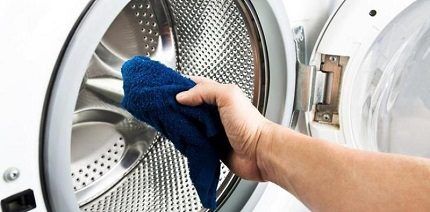
They create a convenient platform for the development of microorganisms and some detergents.If they are of poor quality or used in excess, this will lead to the formation mold in the washing machine.
Washing at low temperatures also contributes to the appearance of a foul odor.
Simple ways to fix the problem
If the smell has just appeared, it can be removed from the washing machine by thoroughly washing all internal surfaces. A warm soap solution is suitable for this. After treatment, you need to wipe all surfaces dry and leave the machine open for a day.
Washing at maximum temperature will also help. Use things that won't fade. At the same time, check whether the machine heats the water to the levels specified in the technical specifications. You can add vinegar, it is harmless to health and kills bacteria.
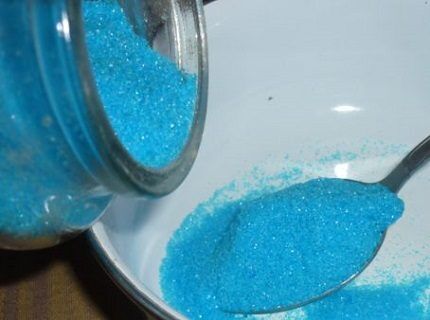
Run the empty machine on the longest setting and maximum temperature. Load the powder container with bleach or dishwasher tablets. When the full cycle is over, do another short rinse.
Usually these manipulations are enough to remove the cause of the unpleasant odor from the washing machine. If it remains, you will have to find the source and solve the problem using more radical methods.
Stages of cleaning activities
Let's try to disassemble the machine and check all accessible parts of the mechanism for the presence of various unpleasant microorganisms on them.
Stage #1 - disassemble the washing machine
To do this, you need to disconnect it from the power supply, water supply and drainage, and provide access to the equipment from all sides.
After disconnecting the washing machine from power, wait 15-20 minutes for all appliances to turn off. It is advisable to move the machine and check the space under it: dirt on the floor or stand can also be a source of an unpleasant odor.
Let's prepare the necessary tools:
- round nose pliers, pliers or pliers;
- Phillips and slotted screwdriver;
- hammer;
- keys - open-end, heads;
- marker;
- an old toothbrush;
- brush (preferably Kevlar);
- flashlight.
First, remove the top, bottom and side covers of the washer. Look at the design: unscrew the panels secured with self-tapping screws, and pull the rest towards you.
The control unit, wires, drum, engine do not need to be touched. If there is dirt on them, carefully remove them. Look inside the machine, shine a flashlight through every detail, remove debris and dust where possible.
More details about how to disassemble a washing machine are written in this material.

Take pictures or film your actions, this will make it easier to put the parts in place later. Now let's look at the individual elements where colonies of microorganisms prefer to live.
Stage #2 - clean or change the cuff
The rubber seal is constantly in contact with moisture and is not able to self-clean due to its shape. Stagnation of liquid in it leads to the formation of rot.
Black spots can be removed with any chlorine-containing solution diluted with water - regular “Belizna” or “Domestos”, “Toilet duck”.
The algorithm of actions is as follows:
- Wear rubber gloves.
- Wash the cuff of the loading hatch with a chlorine-containing solution.
- Close the machine.
- After 30-40 minutes. you need to turn on the rinse mode. But our machine is disassembled and turned off, we’ll do it later.
If it is impossible to wash the cuff or it has become unusable, it can be removed and replaced with a new one. The rubber seal is attached to the tank body with two clamps.
First you need to bend the front edge and remove the first plastic clamp from the latch. If the clamp is metal, it is moved away with a screwdriver.
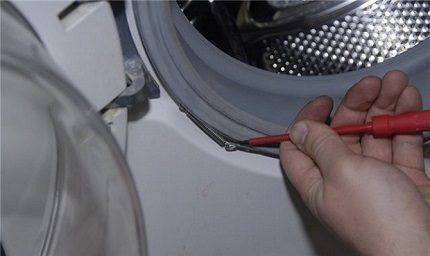
Next, carefully pull out the first part of the cuff and make a mark with a marker so that you can easily insert a new elastic band later. It will then need to be combined with the mark on the tank itself.
We similarly release the other part of the cuff from the second clamp and tuck the elastic band inside the drum.
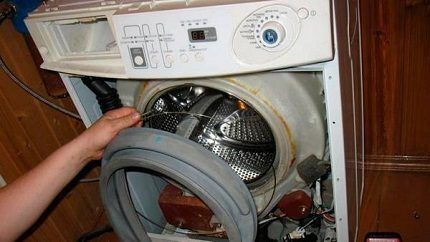
Try washing the removed rubber seal, maybe it will still serve. If nothing can save her, take the old cuff and buy a new one of the same size.
Before installing a new cuff You need to wash the edge of the tank with warm soapy water. Do not wash the soap film, it will serve as a lubricant. To put the elastic in place, place the top of the elastic against the edge of the tank along the marks and use your thumbs to tighten the elastic.

Slide from the center around the circle. When the cuff is in place, check the fit and secure it with clamps.
Stage #3 - clean the detergent loading compartment
Removing the part is quite simple with a top-loading machine - unscrew the plastic screws and remove the tray. In some horizontal-loading washing machines, it is more difficult to pull out. Do not rush to tug and tear out the container.
Look in the instructions for the machine - there are models where it can be removed with one click on the tab near the rinse aid compartment. If the container comes out like a fan, you need to open it all the way, then lift it, pull it towards you and pull it out.
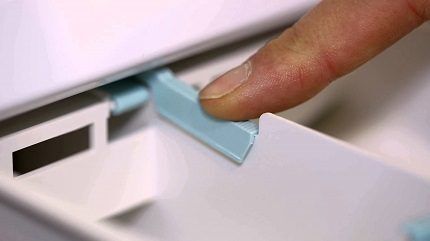
How to remove the straight horizontal detergent tray:
- Pull it all the way.
- Examine the bottom of the container.
- If cloves are visible on both sides deep down, grease them with any vegetable oil.
- Lift the container up and pull it towards you, it will move 1-2 millimeters.
- Press the top of the tray until it clicks and pull, it should come out freely.
After removal, the tray must be cleaned of plaque and mold. Use suitable household chemicals for this. You can fill the tray with soda, vinegar, or vinegar-soda hot solution.
Exposure time - 6-8 hours. After this, the dirt will fall away and be easily removed. Citric acid will also work. Wipe the clean tray dry and place it back in the washing machine compartment.
Stage #4 - cleaning the drainage system
The system can be cleaned without disassembling using special products that remove deposits. Powders, solutions, tablets are used according to the instructions on the package.
Regular soda will also work. 150 g of powder should be poured into the drum and rotated without laundry on the longest setting. But our machine has been disassembled, so we’ll clean everything completely.
To get to the drainage system:
- Cover the floor with a soft cloth and turn the washer on its side.
- Place plenty of rags under the drainage system to prevent any remaining water from damaging the flooring.
- Using a flathead screwdriver, remove the bottom panel.
- Unscrew the bolts that hold the filter.
- Remove the filter.
- Use pliers to loosen the clamp and separate the hose from the pump and housing.
Hose in top-loading machines it is located on the side. To remove it, we release the fasteners, remove the panel, unscrew the clamp, and pull out the hose.
When it is already in your hands, we begin to clean it, inserting a brush from one side or the other. We rinse the hose under running hot water and return it to its place.
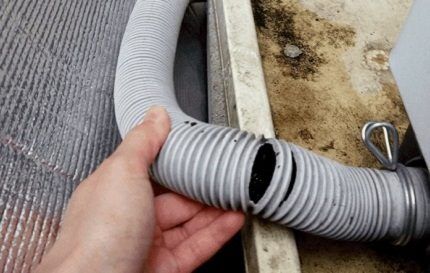
Now let's get started filter. We clean it of all contaminants and rinse it with water. If there is plaque, soak the filter in a citric acid solution for several hours, after which we remove the deposits.
We highlight the place where the filter is installed with a flashlight and also clean it of debris. We return the part to its place.
Don't forget about the filter for a long time. It is easily accessible from the outside of the machine by simply turning the plug itself counterclockwise.
If the filter is secured with a bolt, it is easy to unscrew it without disassembling the machine. The part needs to be cleaned every 2-3 months or six months, depending on the frequency of washing.
You can read a review of the best ways to clean the filter in washing machines Here.
Another participant in the drainage system is pump. Disconnect the wires leading to it and unscrew the device. The most problematic part is the impeller. It is easy to get out by unscrewing the screws that connect the body.
As the washer operates, the impeller rotates, so it wraps around debris. We remove dirt from it, wipe the inside of the pump, clean the hoses and put everything back together.
Stage #5 - clean the water supply channel
Removing the fill tube will reveal the inlet filter. We carefully remove this fine mesh with pliers. Remove it with extreme care; it is very fragile. Happened? Now clean the filter with a toothbrush and rinse with water.
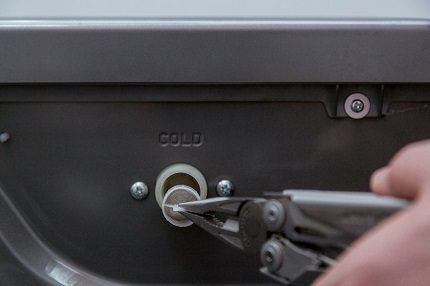
Clean and rinse the filler tube. Often debris collects on its walls and a silty coating appears. Clean with a brush and rinse with hot running water. We connect all the parts together and install them back.
Stage #6 - clean or change the heating element
Scale on the coil (TENE) is another source of bad odor. This is not quite a traditional coating, like on the walls of a teapot. It is formed not so much from the quality of the water as from debris and detergent residues.
If you rarely use the machine and turn it on at minimum temperature, the plaque begins to rot, emitting a characteristic “aroma” in the process. But high washing temperatures do not help - a burning smell appears.
There are two ways to remove scale: physical and chemical. Physical involves removing plaque manually with hard objects.
It is not recommended to do this yourself; there is a risk of damaging the spiral. Let's make do with a chemical one, use a solution of citric acid. But more on that later.
Let's see what condition the heating element is in. Remember, at the very beginning, when washing at maximum temperature, you had to check whether the water was warm enough? Maybe the machine washes without heating and this is the reason for the unpleasant smell?
Then you need to replace the heating element. In most models it is located at the back, so it is not difficult to find.
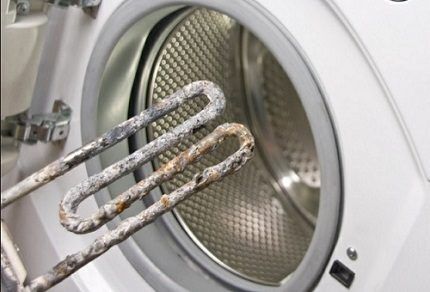
Let's take a closer look heating element replacement process:
- Remove the wires from the heating element.
- We turn the fixing nut in the middle of the heating element (let it remain on the edge of the thread, do not remove it).
- We press the nut inward, you can tap it with a hammer.
- We take out the heating element. If it doesn’t work, pry it off with a slotted screwdriver or a knife.
- We put the old part aside and install the new one, repeating the algorithm in reverse order.
If you still don’t need to replace the heating element, the amount of scale is not critical, return all the parts to their place, close the machine, tighten all the bolts, connect it to water and electricity.
Pour 150-200 g of citric acid into the powder container, set the longest mode at maximum temperature and run the washing machine without laundry.
If you have cleaned all the places where microorganisms could develop their vital activity, replaced parts that have become unusable, but the unpleasant odor remains, the problem is hidden in the general building communications.
This is evidenced by the smell of rot from the shells. Contact your service company. It’s good if the unpleasant smell has disappeared, but how to prevent such a situation in the future?
Odor control methods
Check pockets before washing. Paper napkins, crumbs, and candy become an excellent substrate for the development of mold. Place things with lint or small parts in special bags or nets.
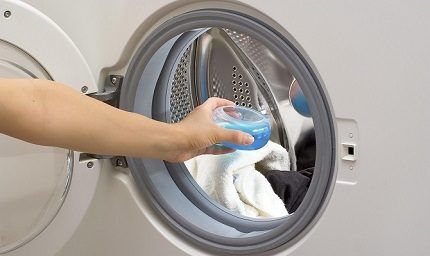
And a few more recommendations:
- Leave the machine open between uses.
- Remove the washed laundry from the drum immediately after the selected program has finished.
- Set the washing temperature to at least 40 degrees.
- Use the extra rinse mode.
- Wipe the interior surfaces of the machine dry.
- Remove, wash and dry the detergent loading compartment.
- Don't forget to clean the filter - one of the dirtiest places in the washing machine, it is often the source of unpleasant odors.
- Do not use cheap and low-quality powders, balms, bleaches, and conditioners.
Load detergents in the quantities specified by the manufacturer. Residues will not settle on the walls of the tank, creating a nutrient medium for the life of microorganisms.
Proper operation is the key to reliable and long service life of the washing machine.Wipe it, ventilate it, periodically clean the places where bacteria and fungi like to settle, and the laundry will always smell fresh and not like swamp mud.
Conclusions and useful video on the topic
A visual demonstration of removing and replacing parts will help you better understand the processes.
The nuances of replacing the heating element are discussed in the following video:
Cleaning the drain filter:
The unpleasant odor from the washing machine is transmitted to clothes and penetrates into living spaces. It’s easier to get rid of it than to endure the “fragrances” all the time.
To eliminate odors coming from the washing machine, use high-quality detergents, rinse and clean working parts - and washing will bring only positive emotions.
Do you have any questions about the topic of this article? You can ask them in the comments block below. There you can also share your own experience of dealing with unpleasant odors from your washing machine.




There is some problem with my washing machine. In addition to the unpleasant smell, the gum leaks. I can clean and run the washer with bleach at maximum temperature. Tell me what to do with the elastic band. Where can I buy a new one? Can my husband handle the replacement or is it better to call a professional? The warranty was removed a long time ago. Could there be another reason for the leak?
If by elastic you mean the cuff, then it is quite possible to replace it yourself. Let your husband watch the video, there are plenty of them on the Internet. There's nothing complicated there.
Think before you use citric acid, I got into trouble.As a preventative measure, I decided to run the machine at 90 degrees with a special product for Tiret washing machines, which contains citric acid. Now there is some kind of rotten smell coming from the machine. Now I don't know how to get rid of it. Before this “prevention” everything was fine. They write on the Internet that the source may be an elastic band in which dirt has accumulated; I will try to remove and clean it.
I don't think it has anything to do with the citric acid. I assume that there was significant dirt, mold or mildew, and one cleaning cycle dissolved it, but did not completely remove it. In such cases, they usually run it again, but lately there have been a lot of complaints about Tiret, and for citric acid it’s a little expensive. Try the option outlined in the article with copper sulfate or try it again with regular lemon juice.